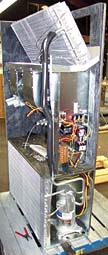
In a marine or coastal environment, this may be an acceptable condition. Bare copper is fairly resistant to the corrosive effects of salt air. This is why, for many years, copper fin/copper tube (Cu/Cu) coils have been a popular solution for corrosion in marine applications. The all-copper coil will hold up reasonably well against salt air exposure, without the galvanic corrosion inherent with dissimilar metals.
However, what works well in one environment does not necessarily work well in another. Ask anyone who has ever installed a Cu/Cu coil in a sulfur or methane environment. Cu/Cu coils are not a good solution for locations where the unit may be exposed to various aggressive acids and other chemicals. Several specific applications that come to mind include waste water treatment facilities, pulp and paper mills, refineries, chemical plants, meat and dairy processing facilities, and hog and mushroom farms.
These environments contain varying parts per million (ppm) concentrations of chemicals such as methane, ammonia, and sulfur compounds that cause exposed copper to start deteriorating.
Moreover, coating only the U-bends and headers of aluminum-copper (Al/Cu) coils will not prevent chemicals from eating away at the remaining copper tubing left uncoated inside the unit. Pitting on tubing walls may cause pinholes to develop, which in turn cause the coil to leak. Exposed solder joints are particularly vulnerable to attack.

Cover All Bases
The solution for these environments is to provide an effective protective coating for all of the exposed copper in the circuit, as well as the copper on the condenser and evaporator coils. Typically an aftermarket modification/coating service provider can perform these services for new equipment. This is best done before the equipment goes into the field.Once corrosion starts, it is very difficult (and usually not cost-effective) to contain. A small investment at the beginning of a project can bring big savings in terms of possible downtime costs, leak repairs, coil replacements, and unit efficiency losses (increased energy consumption).
On smaller units, the entire refrigerant circuit can be removed for coating. In addition to making the job easier, the circuit is not cut and the refrigerant does not have to be recovered. Larger units may require some disassembly for accessibility. The coils may need to be removed for coating, depending on the extent of access and the coating system used.
Either way, the coils' galvanized end plates should be prepped in accordance with a coating system.

A primer formulated for use on copper should be applied to all exposed tubing to provide an enhanced adhering surface for the topcoat.
Once the primer is dry, the topcoat can be applied to the tubing and the coils.
If the circuit has been cut when the coils were removed for coating, it must be resoldered, tested, and the refrigerant recharged. In this instance, the areas left uncoated for soldering will need to be washed, dried, and touched up with the primer and topcoat.
Griffin is the marketing manager of Blygold America Inc. For more information, call 410-643-6080 or visit www.blygoldamerica.com.
Publication date: 03/08/2004

Report Abusive Comment